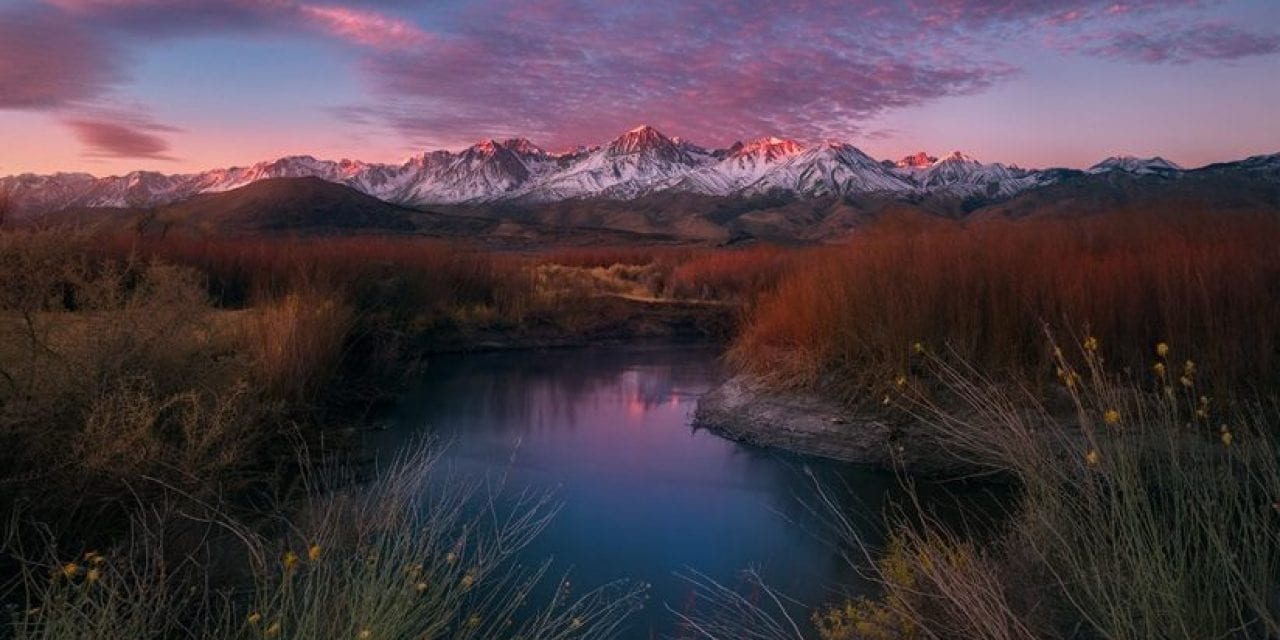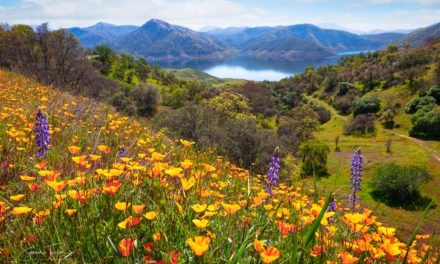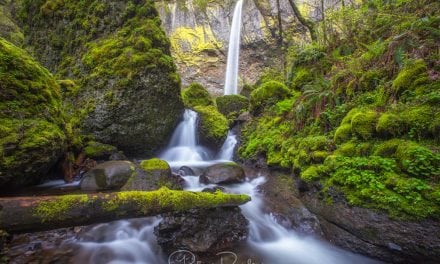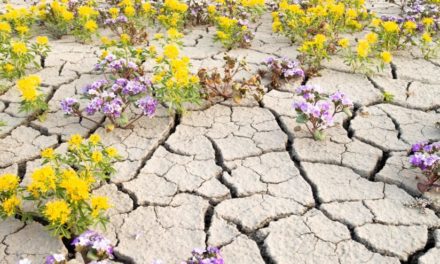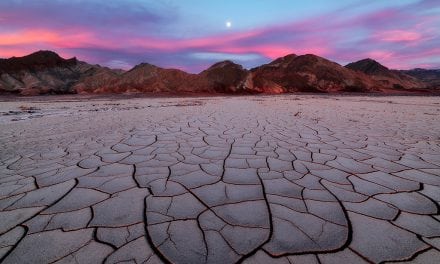It has never been more difficult to make a truly notable landscape photograph. Yes, technology has made mastery of the photographic process more accessible than ever, but it has simultaneously become nearly impossible to create something unique. To stand on the shoulders of those who have come before without recreating the same work is no small feat. Yet that’s exactly what landscape photographer Ted Gore is doing.
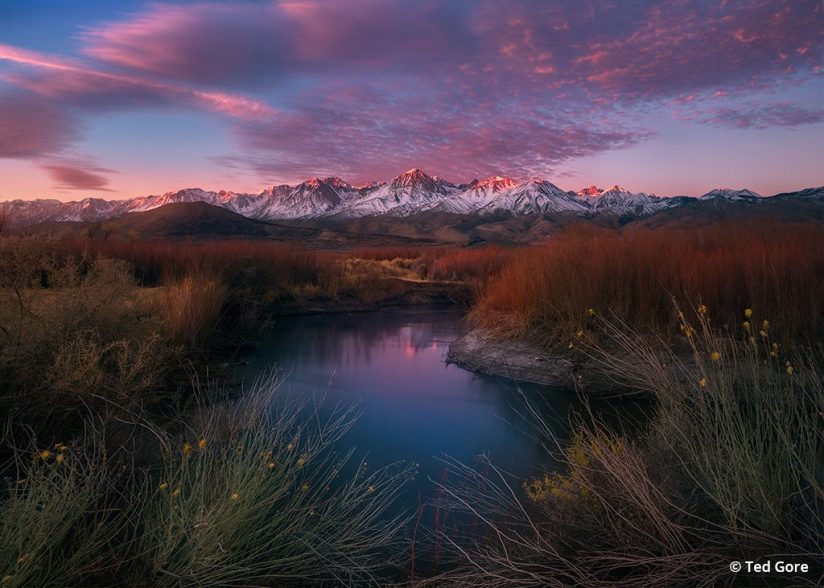
Morning Brush. Winter in the Eastern Sierra reveals a colorful array of foliage that is a highlight of the area and provides the best photographic opportunities. The Owens River meanders on for miles through the Owens River Valley along the base of the impressive High Sierra mountains.
He makes images that are impressively refined and aesthetically unique, traveling to the far corners of the globe to photograph places both famous and unknown. The images here include mountain peaks from California’s Sierras to the Canadian Rockies, Hawaii’s Na Pali Coast to the Italian Dolomites. Gore will travel to almost any length in order to create truly notable landscape imagery. This goes for the locations he chooses as well as the methods he employs.
Origin Of An Artist
Years ago, before a family trip up the California coast, Ted Gore’s father handed him a point-and-shoot digital camera. In the hands of the young outdoorsman, this immediately sparked an interest.
“I remember showing my dad a picture I had taken,” Gore says, “and he imparted some words that have always stuck with me. It was something to the effect of, ‘That looks great, but remember it’s easy to take beautiful pictures of beautiful things. Try taking beautiful pictures of not-beautiful things.’ It really struck me and revealed one of the core foundations of good photography: finding beauty in the unexpected and obscure.”
Gore was studying to be a chemical engineer when, during his senior year at Georgia Tech, he discovered a love for video, filmmaking and motion graphics. That led him on a new path, eventually landing in Los Angeles, where he works as a motion graphic designer on high-profile film and television projects. The visual sophistication and processing techniques he has honed there have helped shape the aesthetic that makes his landscapes so unique.
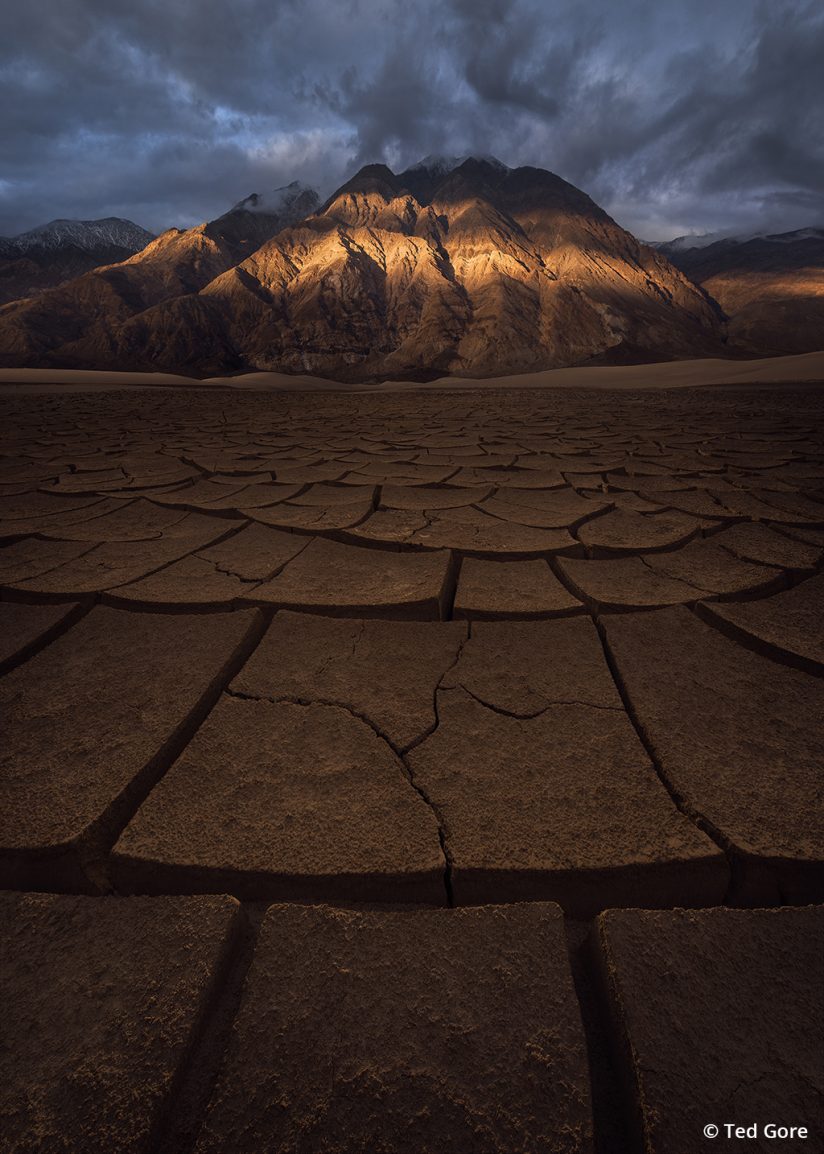
Saline Split. Heavy winter rains followed by long, hot and dry summers create these impressive mud crack patterns in a remote area of Death Valley National Park. Some of these areas can have cracks that are a foot deep! It’s an amazing display of nature in one of the harshest environments in the world. On this morning, the clouds broke in such a way as to send this strip of light across the adjacent mountain, making for a perfect background.
“My career has definitely been related,” he says, “and I think it has given me specific knowledge and tools that have made my adoption of landscape photography somewhat easy. I already knew Photoshop, and my knowledge of graphic design really helped me in understanding how to compose and arrange elements in a scene to flow more pleasingly to the eye. Studying color theory really brought an interesting perspective to landscape photography that I began to discover really isn’t utilized very much.”
In his landscape work, Gore relies heavily on the use of color theory as well as digital imaging in service of images that aim to evoke powerful feelings in the viewer. In fact, he even hesitates to call his work “photography.”
“The topic of image manipulation may go down in eternity as the most hotly debated topic of landscape photography,” he says. “Everyone has an opinion, and I’ve witnessed some all-out wars on the subject—some of which I’ve been a part of. I don’t care to engage on the subject these days because I just don’t see the point anymore. People should decide where they lie on the spectrum of how much manipulation is ‘OK’ and then just put it to rest and go make some images. But yes, on my website I do talk about how I prefer to use the term ‘images’ rather than photographs for my own work because the definition of a photograph is a bit gray, and I do utilize more techniques beyond the capabilities of a camera and what it can give me alone. I guess I just feel a bit uncomfortable calling my work ‘photographs.’ It’s just a personal thing, and I certainly don’t suggest anyone who does any kind of post processing to their images do the same.
“My vision of the images I create is more to evoke the emotion and feeling of the place I’ve made the image of,” Gore continues. “When you are there, the experience is about so much more than what can be portrayed on a two-dimensional image. It’s the air, the smells, the feeling of being there. I set off beyond what the camera alone is able to do to try and breathe a little bit of that experience into my shot so that when someone looks at it, they feel something more.”
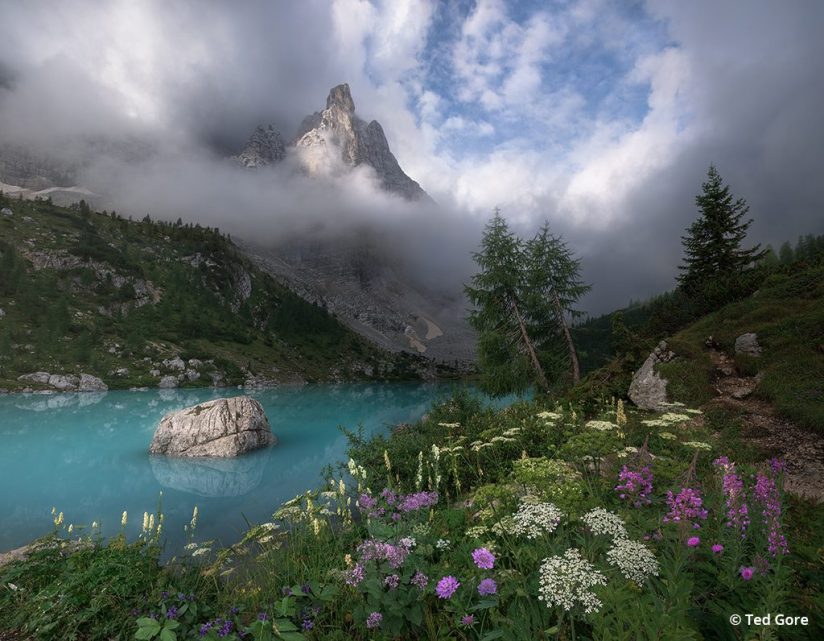
Breaking Fast. Lago di Sorapis in the Dolomites of Italy is a very unique location in the Alps due to its distinct turquoise color that you just don’t see very often. The water gets its color from glacier sediment runoff, and that made for an amazing array of color when combined with purple flowers, green foliage and a blue sky being revealed by swirling clouds. The day began with lots of fog and no view of the mountain. I was set up and ready to shoot, but with no sign of the mountain, after an hour or so I packed up and started heading out. Just as I was leaving, the clouds started opening up, and I hurried to get set back up and snap the conditions before they passed.
Ted Gore’s Unique Technique
To be clear, Gore says, in no way is he an illustrator who creates his images in the computer. They are grounded in traditional photography. It’s simply that he uses multiple exposures and post-processing techniques to make his images come alive. He’s a talented visual artist employing the many tools at his fingertips, as the master manipulators of the traditional darkroom did for decades.
“It’s more about emphasis and accentuation,” Gore explains of his process. “Sometimes exaggeration to, again, breathe a certain life into the image so that it speaks more than the raw image otherwise could. When I create my images, it’s never my goal to be disingenuous about the location. My personal ‘line in the sand’ is to not alter anything to the point that it no longer resembles the location in reality. You can go to any location of an image I’ve created, and every rock, mountain, body of water or other semi-permanent object in the scene will be exactly as it was portrayed in the image. I would never do something like put a lake in front of a mountain where it didn’t exist. But I am fairly liberal with altering, nudging, shifting, accentuating the ephemeral components of nature. I wouldn’t go as far as saying that I’m doing any kind of illustration if we are talking about straight up ‘drawing’ something into the image, but paint in a little extra light or mist here and there to help shape a composition or enhance the atmosphere—I have no problem with that. I also don’t always limit myself to what I can fit into a single frame as seen through a viewfinder. If things are happening in the moment at the place I am shooting, I do often take supplementary images to then pull into the final image.
“For example,” he continues, “if a really awesome-looking cloud is hanging around just outside what I have framed up, I will take a quick snap of that cloud and pull it into frame in processing. Because for me, at the moment, it was part of the experience of being there. In theory, this is nothing more than doing something like a focal length blend, where you combine two images taken at two different focal lengths, to include more from a scene in certain areas but less in others where it isn’t necessarily needed. It’s just a little bit more detailed and free of specific ‘rules.’ For me, a lot of it is trying to recreate an experience versus just the challenge of what can I fit into this rectangle frame with one click. I have nothing against that approach, and I certainly sometimes do that myself, and I understand the appeal of that. There is art in restriction. There is also art in no restriction, and in the end I’m all about how I can make the most beautiful image of the place I’m in, utilizing whatever techniques I have at my disposal. For me, 100 percent accuracy to reality is not important. That isn’t what speaks to me when I am trying to make art out of nature.”
In the stunning image Gore calls “Naupaka’s Journey,” he used focus blending to make a photograph that would otherwise be all but impossible owing to the massive depth of field required for sharpness from the foreground flowers to the peaks in back.
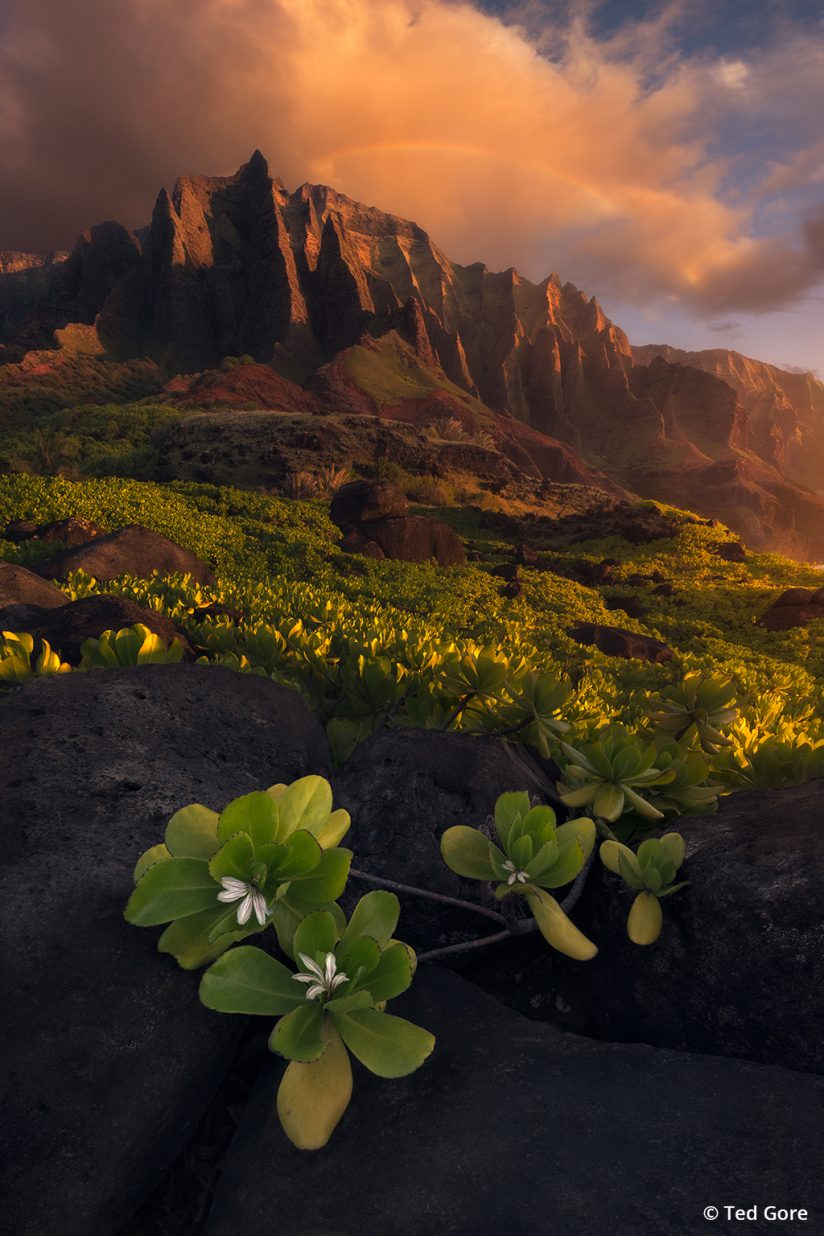
Naupaka’s Journey. An 11-mile, cliff-hugging hike along one of the most stunning stretches of coastline is the one of two ways to (legally) access this area known as Kalalau Beach, the other being by kayak. I ventured out to this beach with a backpack full of gear for a two-night stay in hopes of finding some way of capturing this amazing location. The Hawaiian Islands are covered in the plant that is featured in the foreground, beach naupaka, which carries a legend behind it of lovers separated by class and forbidden to be married, as represented by the half flowers.
“The technique I use is one of manually rack focusing from the closest point to infinity,” he explains, “taking an exposure at small increments through the focus range and then using software like Helicon Focus to blend the exposures together. I mentioned a technique I sometimes use of pulling in dynamic elements of the scene that aren’t necessarily in frame in order to better capture the personal experience I had at the location, and this is an example of doing something like that, where the slight rainbow that showed up was actually more to the left. I chose to capture that separately and pull it into frame to better serve the composition and the overall collection of events that took place while I was there.”
The color in this image—as in all of Gore’s work—is vivid, beautiful and specific. For some photographers who amplify color but lack his skill, their imagery can become candy-like, overtly artificial. Gore, however, strikes a balance between intensity and naturalism. While the colors are bold, they never overpower the structure of the scene. It’s a remarkable talent and something he happily shares with other photographers who want to ensure they don’t overprocess their images and get the colors all wrong.
“When I’m out shooting,” Gore says, “I’m really not actively searching for a shot where all the colors are in harmony because I know that for the most part that if some color does not exactly comply with a harmony, I can tweak it in post processing to bring it more in line. And when I say ‘tweak,’ I’m really only talking about making minor shifts in the color, not completely spinning the hue on it to make it another color. That kind of thing really doesn’t work for landscape photography because of something I call the ‘context of nature.’ Simply put, skies are blue, grass is green, etcetera. If I take some grass and make it cyan because it works better in a harmony, a viewer will ultimately reject that photo because it isn’t what they are expecting grass to look like, and the question of why the grass is cyan will take precedence over how nice the image looks.”
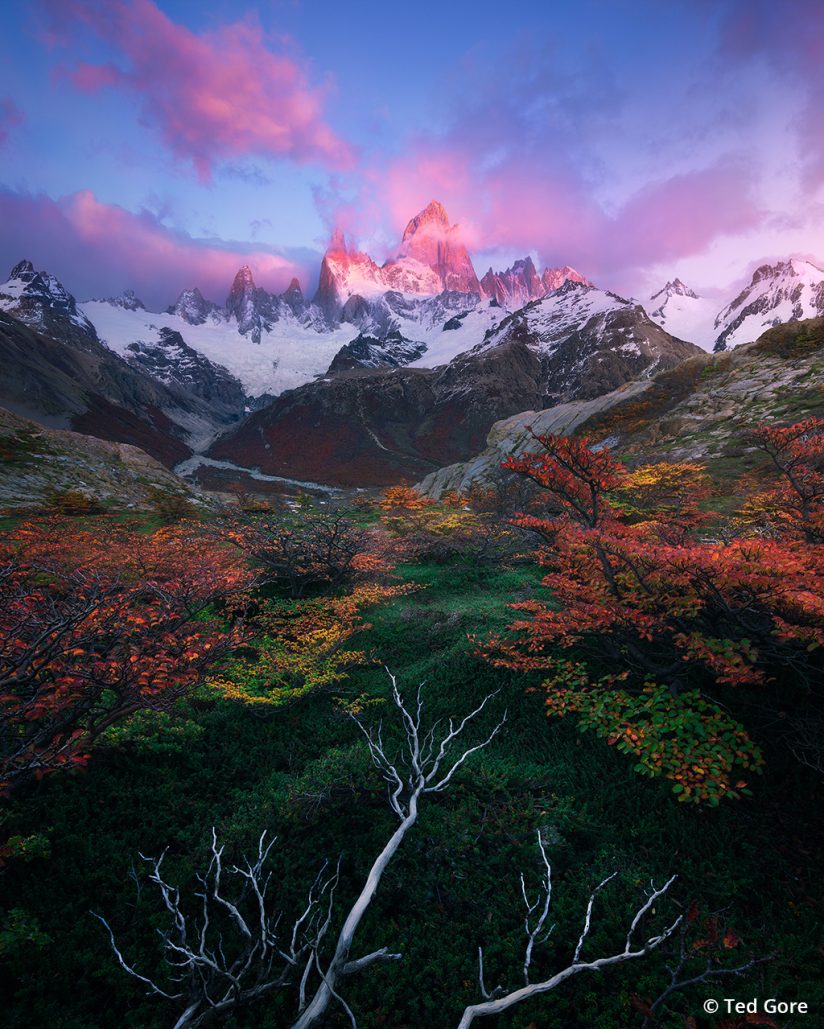
Color Channel. The landscape around Mt. Fitz Roy in autumn is stunning as the lenga trees have a beautiful display of leaves changing a wide range of color. As seen from a vantage point high up on a neighboring ridge, the pink morning sunlight lights up Mt. Fitz Roy, complementing the fall foliage.
“It really comes down to doing something such as shifting the green of the grass to a more yellow-green,” he continues, “a green-green or perhaps a more blue-green if one of those works better in particular. I’ve always found it hard to give other people practical advice on color theory that they can apply because it’s such a nuanced and subtle thing. But if I were to point out something that I think many photographers ‘get wrong,’ it’s to stop making skies Barney purple! It’s always bugged me because in terms of ‘context of nature,’ I’ve never seen a sky look like that.
“Really though,” Gore concludes, “Do what you want. It’s art!”
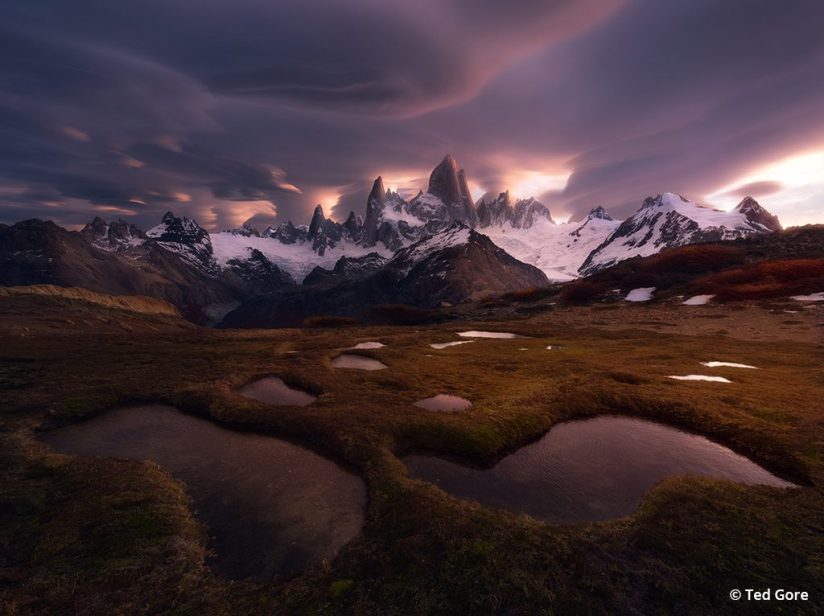
Lenny and Roy. One of the most amazing displays of lenticular clouds formed this day above the massive Mt. Fitz Roy. I watched this cloud system slowly take shape over the course of several hours as seen from this adjacent ridgeline. Some small spring-fed pools made for an interesting foreground in this pristine location.
See more of Ted Gore’s work at tedgorecreative.com.
The post Amongst Giants appeared first on Outdoor Photographer.

